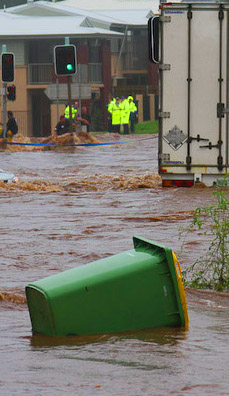Flood rebuild stats revealed
 New stats show the insurance bill for February floods in NSW and QLD has reached $4.8 billion.
New stats show the insurance bill for February floods in NSW and QLD has reached $4.8 billion.
Four months on from a devastating flood disaster, many residents across Queensland and New South Wales are living in limbo, waiting for repairs and to rebuild their lives.
Insurance Council of Australia (ICA) figures reveal the damage bill is up to $4.8 billion, from around 225,000 claims.
The updated stats make the February flood the third costliest natural disaster for insured losses in Australian history, after the 1999 Sydney hailstorm and Cyclone Tracy decimation of Darwin in 1974.
Around 30 per cent of claims for the flooding have been closed, with $1.5 billion paid out by insurers.
ICA general manager of public affairs, Mathew Jones, says commercial claims are still coming in.
“It is Australia's [most] expensive flood, in terms of insurable losses,” Mr Jones said.
“Certainly the fact that this is such a large event is putting strain on insurers' resources.
“Insurers have deployed additional staff and additional resources to process these claims as quickly as possible.
“However, given the scale of the event, it is having an impact on the ability to [quickly] process those claims.
“It was obvious this would be a very significant event as we watched it unfold … south-east Queensland and New South Wales are very populated areas.”
Insurance premiums are rising as extreme weather conditions become more common in Australia.
Mr Jones says this is compounded by the fact that insurance globally is in a “hard market”.
“It means that reinsurance, which is a form of insurance for insurers, is more expensive to obtain and that does have a flow-on effect,” he said.
“We know that in places like Lismore in northern New South Wales there were a decent percentage of people for whom the cost of insurance was just unaffordable.”
The flood disaster has also exacerbated labour shortages, creating even higher demand for skilled tradespeople.
Master Builders Queensland chief executive Paul Bidwell says about 50,000 properties in south-east Queensland need “some kind” of work as a result of the flooding.
“The cost of steel and timber has gone through the roof … the cost of building has gone up around 30 per cent … so adding another 50,000 repair jobs into that equation is making it very challenging for builders and tradies,” Mr Bidwell said.
“When you overlay the impact of price hikes and the delays in getting tradies, [brought on by] COVID-related issues … global supply chains have been smashed.
“The industry across the country is flat out … in fact, across the globe.
“The issue is that we cannot get enough people to do the work and we can't get the products we need at a price that is sustainable.
“There is no silver bullet — there's been a lot of talk about bringing builders and tradies in from other countries but there is no country that has a group sitting there, waiting to get the call.
“It will take years sadly and if you look at what happened back in 2020 with the Halloween hail storm in the western corridor … it probably took two years for all of that work to be completed.”
The ICA has called on state and federal governments to introduce more mitigation strategies to make homes more resilient to natural disasters.







 Print
Print